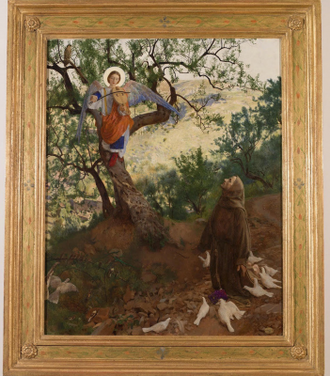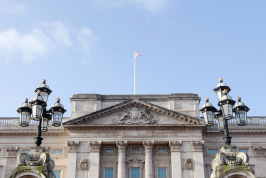St Francis of Assisi at the National Gallery

St Francis of Assisi and the Heavenly Melody 1904. Frank Cadogan Cowper. William Talbot Hillman Collection ©courtesy the owner
St Francis of Assisi is the inspiration for the latest exhibition at the National Gallery, jointly curated by its director, Dr Gabrielle Finaldi, and Joost Joostra, curator in Art and Religion.
Canonised in 1228, two years after his death in 1226, there are more depictions of Francis than any other non-Biblical saint. Over 20,000 representations of him occur, within a century of his death. Contemporary reports described him of medium height, with a 'low forehead, kind black eyes, uptilted ears, scanty beard, lean with slender legs and small feet.' Finaldi argues that Francis' image has evolved as different ages portray aspects of his life that resonate to them. The saints' timeless universal appeal of poverty, inter-faith dialogue and embracing of "embryonic environmentalism" as Finaldi references, stretches across the centuries.
An eclectic mixed media collection of film clips, manuscripts-even a Marvel comic, 'Francis, Brother of the Universe' - alongside superb art and remarkable religious relics explore the popular saint's life and influence.
The exhibition opens with Zurbaran's Spanish baroque image of 'St Francis in Meditation' in his patched Capuchin habit, with hood half covering his face (1635-9) and hands clasping a skull close to his body, reflecting on mortality. When purchased by the National Gallery in 1853, there was consternation as the "repulsive" picture was regarded as too Catholic. Others commented that the painting was unparalleled in technique and intensity of devotional feeling.
Anthony Gormley's 1985 fibreglass, lead and plaster sculpture dominates the room. Gormley's abstract Francis stands in the centre, naked and open armed with eyes on his body depicting the stigmatisation, reflecting the saint's 'inner life.' The artist used himself as model, making a cast of his body.
Richard Long's 2022 circular written reflections in 'A Walk for St Francis' is accompanied by his earlier 'Desert Flowers' and this year's 'River Avon Mud with Crescent.'
The Gallery's own seven colourful panels from Sassetta's wonderful medieval altarpiece, depicting scenes from St Francis' life adorn the next room and include his memorable visit to the Sultan of Egypt during the Fifth Crusade. Room three boasts two of the oldest depictions of the saint. The tempera and gold panel, known as a 'vita-retable' by The Master of the Treasury, circa 1253, is from Assisi in Byzantine style with an elongated Francis in the centre, surrounded by four scenes of miracles, including a healing on the day of his funeral.
Francis' letter to Brother Leo is inscribed with his signature Tau cross, and the drawings by Matthew Paris of St Francis in the Chronica Maiora, are some of the earliest representations 1240c.
Murillo's' magnificent mystical masterpiece of Francis embracing the Crucified Christ towers over the room devoted to inspiring portrayals of Francis during the Catholic Reformation. A hauntingly dramatic El Greco of 'Francis receiving the Stigmata', and an early outstanding 1595 Caraveggio, 'St Francis of Assisi in Ecstasy', being embraced by an achingly beautiful angel are amongst the stunning European and American loans.
Room after room thrills and delights leading us through an artistic paradise and devout reverie!
Examining Francis' relationship with nature, birdsong is relayed in the background as we absorb Andrea Buttner's 2016 colourful woodcut, 'Preaching to the Birds'. Stanley Spencer's 1935 avuncular portrayal of friar and farmyard in 'St Francis and the Birds' and Pre-Raphaelite Frank Cadogan Cowper's luminous 'St Francis of Assisi and the Heavenly Melody', 1904, are yet more highlights.
Room six displays Francis' threadbare, woollen habit and knotted hemp cord, loaned by the Franciscans. In remarkable condition, a sense of holiness exudes from the display case.
Alberto Burri had been a prisoner of war when he began painting. His post war representation of the cross shaped habit, 'Sacko', in sackcloth, oil and fabric on canvas has a blood red wound signifying the stigmata as well as recalling the horrors of war.
Another significant relic is the ivory, wood and silver horn with rods believed to have been given to Francis by the Sultan at their meeting. An inscription indicates that it was used to call the people together for him to preach. It is interesting to reflect that the horn may have been used by both Muslims and Christians as a call to prayer.
Australian Arthur Boyd's emotive expressionist graphic lithographs depicting episodes in Francis,' life were completed whilst living in London in 1963. Six episodes in Francis' life feature in radical form alongside a striking little oil on canvas by Scot Craigie Aitchison placing the saint on the Isle of Arran.
In 1647, aged 16, Josefa de Obidos', talented daughter of a Portuguese artist, painted the radiantly lit 'St Francis and St Claire adoring the Christ Child in a Manger.' Claire's hands are raised as if in blessing whilst Francis' hands cross his chest, exhibiting the stigmata.
Andrea Buttner's 2016 contemporary woodcut expressions of poverty in her series, 'Beggars Suite', portray hunched hooded figures, echoing a friar's habit.
This outstanding, vibrant pilgrimage of art in the steps of St Francis concludes with a collection of works by Giotto.
An excellent illustrated catalogue by the curators is £20.
St Francis of Assisi is at the National Gallery, Trafalgar Square, until 31 July. Admission free.
Tickets can be booked in advance. See National Gallery website for more details www.nationalgallery.org.uk/


















